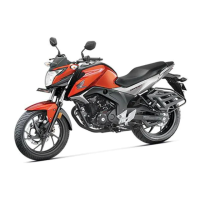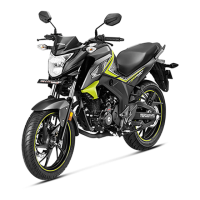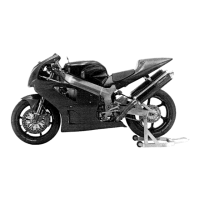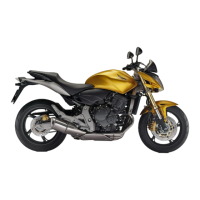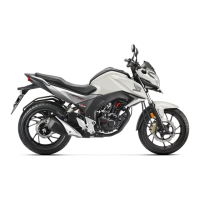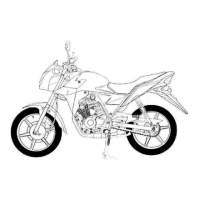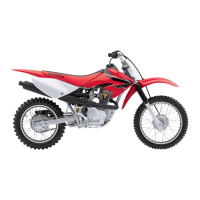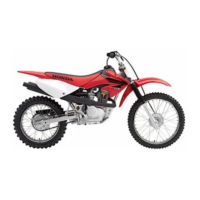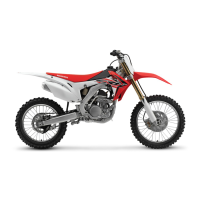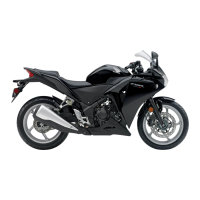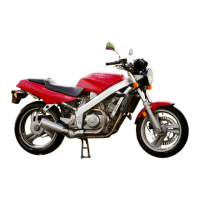
Do you have a question about the Honda Hawk GT NT650 1988 and is the answer not in the manual?
| Year | 1988 |
|---|---|
| Manufacturer | Honda |
| Model | Hawk GT NT650 |
| Category | Motorcycle |
| Displacement | 647 cc |
| Bore x Stroke | 79.0 mm x 66.0 mm |
| Compression Ratio | 9.2:1 |
| Fuel System | Carburetor |
| Ignition | Electronic |
| Starting | Electric |
| Final Drive | Chain |
| Front Suspension | Telescopic fork |
| Front Brake | Single disc |
| Rear Brake | Single disc |
| Front Tire | 110/80-17 |
| Max Power | 58 hp |
| Rear Suspension | Single shock |
| Wheelbase | 1445 mm / 56.9 in |
| Seat Height | 30.7 in (780 mm) |
| Dry Weight | 167 kg |
| Transmission | 5-speed |
Essential safety warnings and precautions for servicing the motorcycle and its components.
Torque values for various frame-related components and mounting bolts.
Procedure for checking and maintaining the engine oil level.
Steps for draining and replacing the engine oil and filter.
Procedure for replacing the engine oil filter.
How to check the engine oil pressure using a gauge.
Scheduled maintenance intervals and required service actions based on mileage.
Procedure for inspecting and adjusting valve clearance while the engine is cold.
Specific instructions for the front cylinder's valve clearance adjustment.
Valve clearance adjustment for the rear cylinder.
Procedure for synchronizing the carburetors using a vacuum gauge.
How to measure cylinder compression and diagnose low compression issues.
Removal, disassembly, and inspection of the radiator and cooling fan.
Inspection, removal, and installation of the water pump assembly.
Inspecting the radiator for leaks, cleaning fins, and straightening bent fins.
Inspecting the water pump's mechanical seal for leakage.
Removing the water pump cover and the pump itself.
Checking the water pump for seal leakage and bearing wear.
Installing the water pump, cover, and filling with coolant and oil.
Step-by-step instructions for removing the carburetors.
Disassembly of the carburetor components for cleaning or repair.
Removal and inspection of float chamber, float, and jets.
Cleaning procedures for the carburetors.
Reassembly procedures for the carburetor after disassembly.
Installation of float chamber, float, and jets.
Measuring and adjusting the float level in the carburetor.
Reassembly of carburetor components, including throttle synchronization.
Installing the carburetors back onto the engine.
Procedure for adjusting the pilot screw for idle speed and mixture.
Draining, refilling, and bleeding the cooling system.
Step-by-step instructions for removing the engine from the frame.
Step-by-step instructions for installing the engine back into the frame.
Steps for removing the right crankcase cover.
Procedure for removing the clutch assembly.
Steps for installing the clutch assembly.
Steps for removing the left crankcase cover.
Procedure for removing the flywheel using special tools.
Disassembly, inspection, and replacement of the starter clutch.
Assembling the starter clutch components.
Installation procedure for the flywheel, including torque specifications.
Installing the left crankcase cover and related components.
Steps for removing the cylinder head covers.
Procedure for removing the camshafts.
Procedure for replacing valve guides using special tools and heating.
Inspecting and refacing valve seats using cutters.
Assembling the cylinder head with valves, springs, and seals.
Installing the cylinder head onto the engine block.
Installing the camshafts, sprockets, and holders.
Removal, inspection, and measurement of the cylinder walls.
Removal and inspection of the piston, including ring-to-groove clearance.
Proper installation of piston rings, including staggering end gaps.
Procedures for removing, disassembling, and assembling the front fork.
Troubleshooting guide for starter motor issues like not turning or not starting the engine.
Troubleshooting for lighting issues (no lights, dim lights) and switch operations.
Torque values for switches and sensors.
Troubleshooting steps when the engine fails to start.
Troubleshooting intermittent starting or stalling problems.
Diagnosing causes for reduced engine power under normal load.
Troubleshooting poor performance specifically at low and idle engine speeds.
Troubleshooting poor performance issues occurring at high engine speeds.

